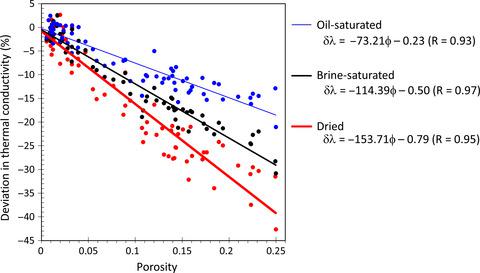当前位置:
X-MOL 学术
›
Basin Res.
›
论文详情
Our official English website, www.x-mol.net, welcomes your feedback! (Note: you will need to create a separate account there.)
On the importance of rock thermal conductivity and heat flow density in basin and petroleum system modelling
Basin Research ( IF 3.2 ) Pub Date : 2019-12-29 , DOI: 10.1111/bre.12427 Evgeny Chekhonin 1 , Yury Popov 1 , Georgy Peshkov 1 , Mikhail Spasennykh 1 , Evgeny Popov 1 , Raisa Romushkevich 1
Basin Research ( IF 3.2 ) Pub Date : 2019-12-29 , DOI: 10.1111/bre.12427 Evgeny Chekhonin 1 , Yury Popov 1 , Georgy Peshkov 1 , Mikhail Spasennykh 1 , Evgeny Popov 1 , Raisa Romushkevich 1
Affiliation

|
[Essential error of widely used geometric mean mixing rule for rock thermal conductivity estimation inferred from experiments as one of pitfalls of basin modelling. , Abstract Basin and petroleum systems are routinely modelled to provide qualitative and quantitative assessments of a hydrocarbon play. The importance of the rock thermal properties and heat flow density in thermal modelling the history of a basin are well‐known, but little attention is paid to assumptions of the thermal conductivity, present‐day heat flow density and thermal history of basins. Assumed values are often far from measured values when data are available to check parameters, and effective thermal conductivity models prescribed in many basin simulators require improvement. The reconstructed thermal history is often justified by a successful calibration to present‐day temperature and vitrinite reflectance data. However, a successful calibration does not guarantee that the reconstruction history is correct. In this paper, we describe the pitfalls in setting the thermal conductivity and heat flow density in basin models and the typical uncertainties in these parameters, and we estimate the consequences by means of a one‐dimensional model of the super‐deep Tyumen SG‐6 well area that benefits from large amounts of reliable input and calibration data. The results show that the entire approach to present‐day heat flow evaluations needs to be reassessed. Unreliable heat flow density data along with a lack of measurements of rock thermal properties of cores can undermine the quality of basin and petroleum system modelling.]
中文翻译:

岩石热导率和热流密度在盆地和石油系统建模中的重要性
[广泛使用的用于岩石热导率估计的几何平均混合规则的基本误差从实验推断为盆地建模的陷阱之一。, 摘要 盆地和石油系统通常被建模以提供对油气藏的定性和定量评估。岩石热特性和热流密度在盆地历史热建模中的重要性是众所周知的,但很少关注盆地的热导率、当今热流密度和热历史的假设。当数据可用于检查参数时,假设值通常与测量值相差甚远,并且许多盆地模拟器中规定的有效热导率模型需要改进。重建的热历史通常可以通过对当前温度和镜质反射数据的成功校准来证明。然而,成功的校准并不能保证重建历史是正确的。在本文中,我们描述了在盆地模型中设置热导率和热流密度的陷阱以及这些参数的典型不确定性,并通过超深秋明 SG-6 的一维模型估计了后果受益于大量可靠输入和校准数据的井区。结果表明,需要重新评估当今热流评估的整个方法。不可靠的热流密度数据以及岩心岩石热特性测量的缺乏会破坏盆地和石油系统建模的质量。] 成功的校准并不能保证重建历史是正确的。在本文中,我们描述了在盆地模型中设置热导率和热流密度的陷阱以及这些参数的典型不确定性,并通过超深秋明 SG-6 的一维模型估计了后果受益于大量可靠输入和校准数据的井区。结果表明,需要重新评估当今热流评估的整个方法。不可靠的热流密度数据以及岩心岩石热特性测量的缺乏会破坏盆地和石油系统建模的质量。] 成功的校准并不能保证重建历史是正确的。在本文中,我们描述了在盆地模型中设置热导率和热流密度的陷阱以及这些参数的典型不确定性,并通过超深秋明 SG-6 的一维模型估计了后果受益于大量可靠输入和校准数据的井区。结果表明,需要重新评估当今热流评估的整个方法。不可靠的热流密度数据以及岩心岩石热特性测量的缺乏会破坏盆地和石油系统建模的质量。] 我们描述了在盆地模型中设置热导率和热流密度的陷阱以及这些参数的典型不确定性,我们通过超深秋明 SG-6 井区的一维模型来估计后果,这有利于来自大量可靠的输入和校准数据。结果表明,需要重新评估当今热流评估的整个方法。不可靠的热流密度数据以及岩心岩石热特性测量的缺乏会破坏盆地和石油系统建模的质量。] 我们描述了在盆地模型中设置热导率和热流密度的陷阱以及这些参数的典型不确定性,我们通过超深秋明 SG-6 井区的一维模型来估计后果,这有利于来自大量可靠的输入和校准数据。结果表明,需要重新评估当今热流评估的整个方法。不可靠的热流密度数据以及岩心岩石热特性测量的缺乏会破坏盆地和石油系统建模的质量。] 结果表明,需要重新评估当今热流评估的整个方法。不可靠的热流密度数据以及岩心岩石热特性测量的缺乏会破坏盆地和石油系统建模的质量。] 结果表明,需要重新评估当今热流评估的整个方法。不可靠的热流密度数据以及岩心岩石热特性测量的缺乏会破坏盆地和石油系统建模的质量。]
更新日期:2019-12-29
中文翻译:

岩石热导率和热流密度在盆地和石油系统建模中的重要性
[广泛使用的用于岩石热导率估计的几何平均混合规则的基本误差从实验推断为盆地建模的陷阱之一。, 摘要 盆地和石油系统通常被建模以提供对油气藏的定性和定量评估。岩石热特性和热流密度在盆地历史热建模中的重要性是众所周知的,但很少关注盆地的热导率、当今热流密度和热历史的假设。当数据可用于检查参数时,假设值通常与测量值相差甚远,并且许多盆地模拟器中规定的有效热导率模型需要改进。重建的热历史通常可以通过对当前温度和镜质反射数据的成功校准来证明。然而,成功的校准并不能保证重建历史是正确的。在本文中,我们描述了在盆地模型中设置热导率和热流密度的陷阱以及这些参数的典型不确定性,并通过超深秋明 SG-6 的一维模型估计了后果受益于大量可靠输入和校准数据的井区。结果表明,需要重新评估当今热流评估的整个方法。不可靠的热流密度数据以及岩心岩石热特性测量的缺乏会破坏盆地和石油系统建模的质量。] 成功的校准并不能保证重建历史是正确的。在本文中,我们描述了在盆地模型中设置热导率和热流密度的陷阱以及这些参数的典型不确定性,并通过超深秋明 SG-6 的一维模型估计了后果受益于大量可靠输入和校准数据的井区。结果表明,需要重新评估当今热流评估的整个方法。不可靠的热流密度数据以及岩心岩石热特性测量的缺乏会破坏盆地和石油系统建模的质量。] 成功的校准并不能保证重建历史是正确的。在本文中,我们描述了在盆地模型中设置热导率和热流密度的陷阱以及这些参数的典型不确定性,并通过超深秋明 SG-6 的一维模型估计了后果受益于大量可靠输入和校准数据的井区。结果表明,需要重新评估当今热流评估的整个方法。不可靠的热流密度数据以及岩心岩石热特性测量的缺乏会破坏盆地和石油系统建模的质量。] 我们描述了在盆地模型中设置热导率和热流密度的陷阱以及这些参数的典型不确定性,我们通过超深秋明 SG-6 井区的一维模型来估计后果,这有利于来自大量可靠的输入和校准数据。结果表明,需要重新评估当今热流评估的整个方法。不可靠的热流密度数据以及岩心岩石热特性测量的缺乏会破坏盆地和石油系统建模的质量。] 我们描述了在盆地模型中设置热导率和热流密度的陷阱以及这些参数的典型不确定性,我们通过超深秋明 SG-6 井区的一维模型来估计后果,这有利于来自大量可靠的输入和校准数据。结果表明,需要重新评估当今热流评估的整个方法。不可靠的热流密度数据以及岩心岩石热特性测量的缺乏会破坏盆地和石油系统建模的质量。] 结果表明,需要重新评估当今热流评估的整个方法。不可靠的热流密度数据以及岩心岩石热特性测量的缺乏会破坏盆地和石油系统建模的质量。] 结果表明,需要重新评估当今热流评估的整个方法。不可靠的热流密度数据以及岩心岩石热特性测量的缺乏会破坏盆地和石油系统建模的质量。]



























 京公网安备 11010802027423号
京公网安备 11010802027423号